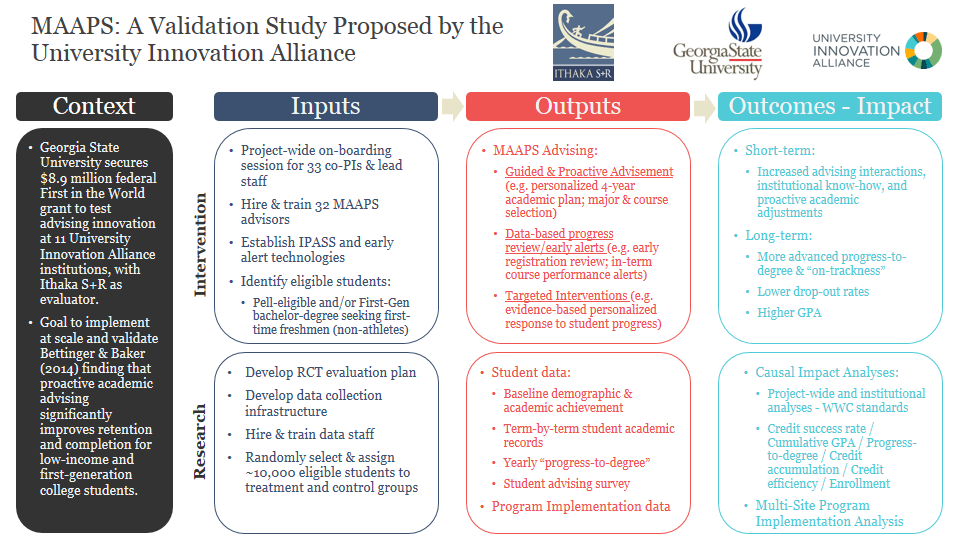Large Advising Study Launches
Many Opportunities to Learn
After a busy planning year, Ithaka S+R and the 11 public universities that are a part of the University Innovation Alliance recently launched the Monitoring Advising Analytics to Promote Success (MAAPS) study. As my colleague Martin Kurzweil explained last fall when the project was just getting started, MAAPS consists of an intensive proactive and technology-enhanced advisement intervention for first-time low-income and/or first-generation freshmen. It is funded by a First in the World grant from the Department of Education, with Georgia State University as the lead institution and Ithaka S+R as evaluator (see figure 1 below for a visual summary of the MAAPS project).
Since the start of the Fall 2016 term, approximately 5,000 students have begun to receive the following advising services, as well as those typically offered at their campus:
- Intensive, proactive advisement: MAAPS advisors will work individually with students to discuss and develop individualized academic maps that chart out the best trajectory for completing the student’s intended course of study. This includes personalizing recommended course selection based on the student’s skills and preferences, prior earned credit, need for developmental coursework, and the specifics of their program of study. Advisors will draw on technological tools to guide students in major and course selection when relevant, and meet with students periodically to review and revise their academic map as needed.
- Real-time alerts prompted by a system of analytics-based tracking: Using IPASS systems or other site-specific technologies or strategies, advisors will draw on early and real-time alerts to identify students who can benefit from additional proactive advisement and early intervention before they go too far off path academically, lose financial aid opportunities, or delay degree completion.
- Timely, targeted advising interventions: Based on the alerts-based system and intensive advising relationship advisors develop with their students, they are especially well-positioned to provide targeted advising interventions as needed, tailoring their interventions to a student’s specific needs at a given point in time. This includes helping a student get back on the appropriate academic path, explore new academic paths if necessary, and identify and seek additional academic and personal resources on- and off-campus.
Together, the features of the intervention are expected to increase students’ sense of support, institutional know-how, and academic self-efficacy and optimism, and to help reduce wasted credits and boost retention and timely degree completion. The low student-advisor ratio of about 1:150 is intended to promote MAAPS’ goals by allowing advisors to truly personalize advisement and work intensively and proactively with students.
The intervention is accompanied by an impact evaluation study and an implementation study, conducted by Ithaka S+R. As part of the randomized trial, approximately 10,000 students across the 11 institutions have been randomly selected into intervention and control groups, and their academic outcomes are being tracked over at least three years. In addition to standard outcomes such as credits accumulated, GPA, and courses completed, the study also tracks students’ yearly “progress-to-degree.” Progress-to-degree reflects the percentage of required credits that a student will have earned to date, out of the total credits required for the student to complete their specific course of study. This outcome is carefully tracked by trained advisors, who assess not only whether courses were successfully completed but whether they have earned the student credit toward their chosen program or course of study in specific.
The implementation study, which takes place over the course of the project, including the planning year, documents how each individual site is implementing MAAPS, the strengths and challenges faced in introducing this advising intervention on campuses with different existing advising structures, lessons learned from carrying out a cross-state multi-institution project of this scale, and best practices for providing implementation support and sharing resources across institutions. Ithaka S+R and Georgia State will publish findings from the implementation study periodically throughout the course of the project, ahead of the impact evaluation findings in 2019, to share this information with the broader higher education community.
The findings of the MAAPS study will help higher education institutions address some of their most important current challenges and opportunities, including supporting first-year students, especially low-income and first-generation students, designing institutional processes around students’ needs and experiences, integrating early alert strategies and technologies into student advising, promoting timely degree completion, streamlining academic pathways for students, and promoting implementation support and resource sharing for institutions. Stay tuned for more insights.
Figure 1.
